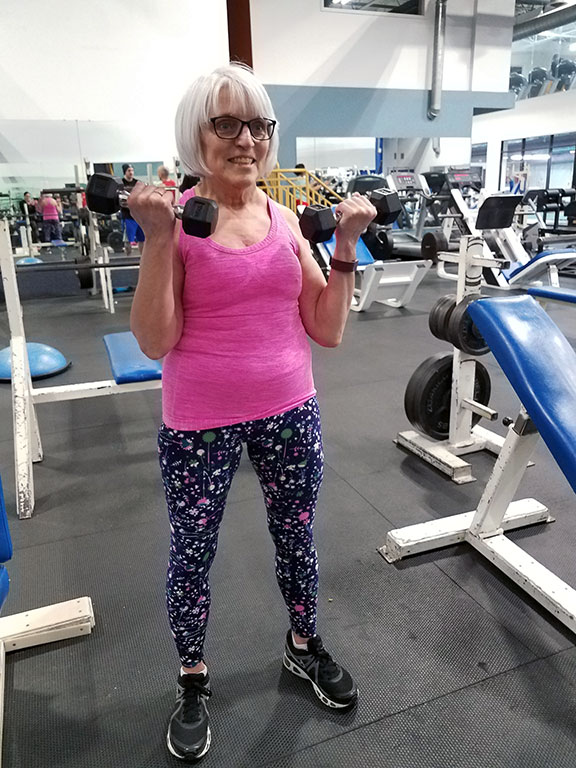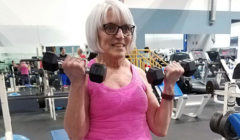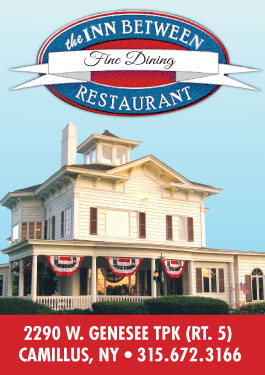Forever Young
Did you know that just one out of four people between the ages of sixty-five and seventy-four exercises regularly? Starting or maintaining a regular exercise routine can be a challenge at any age, but as you get older you may have additional concerns. Are you afraid of falling? Getting injured while working out? Maybe you don’t know where to begin or worry that you won’t be the athlete you once were.
Exercise is good for people of any age. It can help boost your energy, make you
stronger, prevent bone loss, improve balance and coordination, build confidence, protect your heart, help maintain your independence and ease the symptoms of many chronic conditions. Regular exercise is also good for your mind, mood, and memory. Below are six myths about activity and aging.

70 year old Champions Fitness Center member Pat Orr works out regularly with a pers onal trainer and takes several Group Fitness Classes.
Myth 1: There’s no point in exercising. I’m going to get old anyway.
Fact: Regular physical activity helps you look and feel younger and stay independent longer. It also lowers your risk of a variety of conditions, including Alzheimer’s and
dementia, heart disease, diabetes, certain cancers, high blood pressure, and obesity.
Myth 2: Exercise puts me at risk of falling.
Fact: Regular exercise, by building strength and stamina, prevents loss of bone mass and improves balance, actually reducing your risk of falling.
Myth 3: It’s too frustrating. I’ll never be the athlete I once was.
Fact: Changes in hormones, metabolism, bone density, and muscle mass mean that strength and performance levels inevitably decline with age, but that doesn’t mean you can no longer derive a sense of achievement from physical activity or improve your health. The key is to set fitness goals that are sensible for your age. A sedentary lifestyle takes a much greater toll on athletic ability than biological aging.
Myth 4: I’m too old.
Fact: You’re never too old to start an exercise program! In fact, adults who become active later in life often show greater physical and mental improvements than their younger counterparts.
Myth 5: I can’t exercise because I’m disabled.
Fact: Chair-bound people face special challenges, but can lift light weights, stretch, and do chair aerobics, chair yoga, and chair Tai Chi to increase range of motion, improve muscle tone and flexibility, and promote cardiovascular health. Many swimming pools offer access to individuals in a wheelchair and there are adaptive exercise programs for wheelchair sports such as basketball.
Myth 6: I’m too weak and have too many aches and pains.
Fact: Staying active can help manage pain and improve your strength. Many older people find that regular activity not only helps slow the decline in strength and vitality that comes with age, but actually improves it.
Physical health benefits
• Helps you maintain or lose weight. As your metabolism naturally slows with age, maintaining a healthy weight is a challenge. Exercise helps increase your metabolism and builds muscle mass, helping to burn more calories.
• Reduces the impact of illness and chronic disease. People who exercise tend to have improved immune and digestive functioning, better blood pressure and bone density, and a lower risk of Alzheimer’s disease, diabetes, obesity, heart disease, osteoporosis, and certain cancers.
• Enhances mobility, flexibility, and balance. Exercise improves your strength, flexibility and posture, which in turn will help with balance and coordination, reducing the risk of falling. Strength training also helps alleviate the symptoms of chronic conditions such as arthritis.
Mental health benefits
• Improves sleep. Quality sleep is vital for your overall health. Regular activity can help you fall asleep more quickly, sleep more deeply, and wake feeling more energetic and refreshed.
• Boosts mood and self-confidence. Exercise is a huge stress reliever and the endorphins produced can actually help reduce feelings of sadness, depression, and anxiety. Being active and feeling strong naturally helps you feel more self-confident.
• Does amazing things for the brain. Exercise can help brain functions as diverse as multitasking and creativity and can help prevent memory loss, cognitive decline, and dementia. Getting and staying active may even help slow the progression of brain disorders such as Alzheimer’s disease.
Building a balanced exercise plan
Staying active is not a science. Just remember that mixing different types of physical activity helps both to keep your workouts interesting and improve your overall health. The key is to find activities that you enjoy based on the four building blocks of fitness. These are:

75 year old Joanne Moffatt enjoys taking Kickboxing classes at Champions and is on a bowling league called “Young at Heart.”
Balance
What it is: Maintains standing and stability, whether you’re stationary or moving around. Try yoga, Tai Chi, and stability exercises using a Bous ball or resistance ball.
Why it’s good for you: Improves balance, posture, and the quality of your walking. It also reduces the risk of falling and the fear of falling.
Cardio
What it is: Uses large muscle groups in rhythmic motions over a period of time. Cardio workouts get your heart pumping and you may even feel a little short of breath. Includes walking, stair climbing, swimming, hiking, cycling, rowing, tennis, and dancing.
Why it’s good for you: Helps reduce fatigue and shortness of breath. Promotes independence by improving
endurance for daily activities such as walking, house cleaning, grocery shopping and running errands.
Strength training
What it is: Builds up muscle with repetitive motion using weight or external resistance from body weight, machines, free weights, or resistance bands.
Why it’s good for you: Strength training helps prevent loss of bone mass, builds muscle, and improves balance – both important in staying active and reducing the risk of falling. Building strength will help you stay independent and make day-to-day activities such as opening a jar, getting in and out of a car, and lifting objects easier.
Flexibility
What it is: Challenges the ability of your body’s joints to move freely through a full range of motion. This can be done through stationary stretches and stretches that involve movement to keep your muscles and joints supple and less prone to injury. Yoga is an excellent means of improving flexibility.
Why it’s good for you: Helps your body stay limber and increases your range of movement for ordinary physical activities such as looking behind you while driving, tying your shoes, shampooing your hair, and playing with your grandchildren.
In Conclusion:
No matter your age or physical condition, it’s never too late to get started! Becoming more active can improve your health, boost your energy, relieve stress, improve your overall sense of well-being, and help you manage symptoms of illness and pain.
Exercise is the ticket to living well into your golden years! Physical activity is the number one contributor to longevity. Remember, getting and staying active is not just about adding years to your life, it’s about adding life to your years. Good luck to you!
I have been a personal trainer for over seventeen years and I absolutely love what I do. I honestly feel that I have one of the best jobs out there! The most rewarding part of my profession is helping one of my clients succeed at reaching their personal fitness goals. Making a difference in someone’s life makes it all worthwhile. I am currently certified by the National Sports Conditioning Association, Apex Fitness Group, and the International Sports Science Association.











